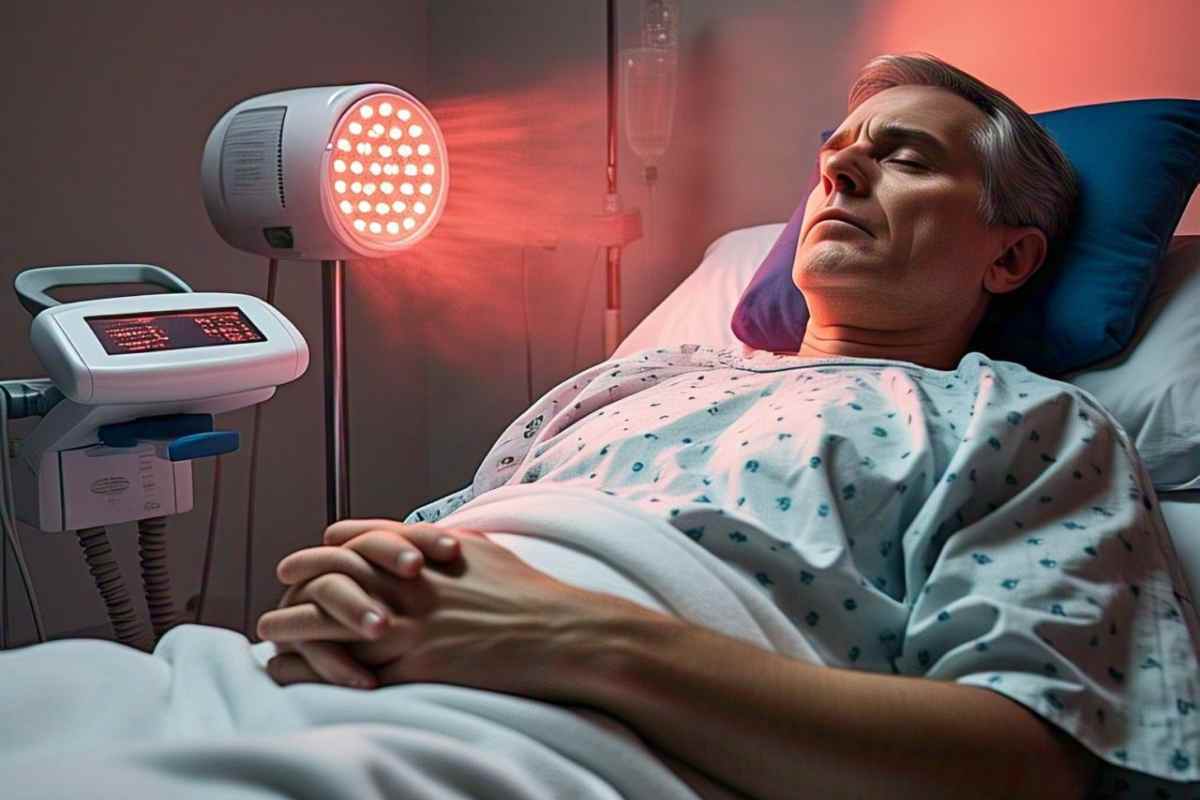Who Should Not Do Red Light Therapy?

Table of contents
Red light therapy offers many benefits, but it’s not for everyone. While it's generally safe, certain people should approach it with caution.
If you have specific health conditions, sensitive skin, or take certain medications, this therapy may not be suitable for you. Keep reading to find out who should avoid red light therapy and why.

Key Takeaways
-
Red light therapy is generally safe, but it may not be suitable for everyone, especially those with sensitive skin or specific health conditions.
-
Consult your doctor before using red light therapy if you have skin conditions, are pregnant, or take photosensitive medications.
-
For children, elderly individuals, and infants, red light therapy can be beneficial, but proper guidance and caution are required.
-
Overusing red light therapy or using it incorrectly can cause skin irritation, burns, or eye damage.
-
Always follow the manufacturer’s guidelines and consult with a healthcare professional to ensure safety and effectiveness.
Is Red Light Therapy Safe for Everyone?
- Most people can use red light therapy without problems: Red light therapy is usually safe and well-tolerated. Most users don’t face serious issues, but safety can vary from person to person.
- Some people may get skin irritation or mild headaches: Those with sensitive skin might notice redness, irritation, or even slight headaches after treatment. These effects are usually mild but worth watching out for.
- People with light sensitivity should be very careful: If you have a condition that makes you sensitive to light, this therapy might make things worse or cause discomfort.
- Not protecting your eyes can cause strain or damage: Red light can be strong on the eyes. Using eye protection during therapy helps prevent strain or long-term damage.
- Some medicines make your skin react more to the light: Medications like antibiotics or acne treatments can make your skin more sensitive, increasing the chance of side effects.
- Using red light therapy too much can harm your skin: Too many sessions or long exposure can lead to minor skin damage. It’s important not to overdo it.
- Asking a doctor first can help you avoid problems: If you’re not sure whether red light therapy is safe for you, it’s best to check with a doctor before starting.
Age-Specific Considerations for using red light therapy
Children or Teens
- Children and teens should use red light therapy carefully: Red light therapy is generally safe, but younger bodies are still developing, so it's important to be extra careful when using it on kids or teenagers.
- It can help with skin problems like acne and eczema in young people: For children and teens, red light therapy can reduce skin issues such as acne or eczema by calming inflammation and helping the skin heal faster.
- Teens should keep their therapy sessions short and not too frequent: Experts recommend that teenagers use red light therapy only 2–3 times a week, with sessions lasting just 10–15 minutes to avoid stressing young skin.
- Red light may also help with eye problems in children: A new study found that red light therapy could slow down worsening eyesight (myopia) in kids with certain eye conditions, without causing harm to their vision.
- We still don’t know how red light affects growing children in the long run: Even though some results look good, researchers are still studying how safe it is for children to use red light therapy over many months or years.
- Red light therapy might change how teens sleep: Some teens may notice changes in their sleep after using red light therapy. It’s a good idea to keep an eye on how it affects their sleep routine.
- Parents should always talk to a doctor before starting therapy: Before using red light therapy on a child or teen, it’s best to speak with a pediatrician to make sure it’s the right choice for their health or skin condition.
Elderly
- Red light therapy helps older people move with less pain: Red light therapy can ease joint pain and arthritis symptoms, which are common problems for seniors. It helps reduce stiffness and discomfort, making daily movement easier.
- It makes aging skin look healthier and younger: This therapy helps boost collagen, which smooths fine lines and wrinkles. Seniors using red light regularly may notice their skin becoming firmer, brighter, and more youthful-looking over time. " says Lauren Fine , a board-certified dermatologist and faculty member at Northwestern University Feinberg School of Medicine.
- It supports the body’s natural healing as we get older: As people age, the body heals more slowly. Red light therapy supports cell repair and regeneration, helping older adults recover better from daily wear and tear.
- It reduces swelling and keeps the skin in better shape: Along with improving how the skin looks, red light therapy helps reduce redness, irritation, and inflammation, common skin issues for elderly individuals.
- Seniors with medical implants need to be careful: If an older adult has a pacemaker or other implant, they should talk to their doctor before using red light therapy. The light could affect how these medical devices work.
Infants
Red light therapy can be used safely on newborns, but it’s important to use the right approach. The recommended wavelengths for infants are usually shorter, as their skin is more sensitive. Overexposure can be harmful, so it’s crucial to avoid excessive use. This therapy has been shown to help with newborn jaundice and may promote better sleep patterns for babies. Parents should always follow proper guidelines and consult a pediatrician to ensure safety.
Who Should Talk to a Doctor Before Starting Red Light Therapy?
People with Skin Conditions
- People with eczema should check with a doctor first: If you have eczema, red light therapy might help reduce inflammation, but in some cases, it can also make flare-ups worse. Always check with your doctor before starting.
- Atopic dermatitis makes treatment choices more serious: Atopic dermatitis, the most common kind of eczema, can cause intense itching, sleep problems, and mental stress. That’s why it’s important to be extra careful with new treatments like red light therapy.
- Red light therapy isn’t always safe for acne and rosacea: People with severe acne or rosacea need to be cautious. Some light therapies might help, but others can irritate your skin or make your condition worse. Always get medical advice.
- Skin infections need to be treated before using red light: If you have a skin infection, don’t use red light therapy until it’s fully healed. Using it too soon could cause more harm than good.
- Anyone who’s had skin cancer needs medical approval: If you’ve had skin cancer before, talk to your doctor before trying red light therapy. It may not be safe depending on the type and history of your cancer.
- Mixing red light with creams or medicines can be risky: If you're using skin creams or medications, red light therapy could either help more or cause problems. That’s why it’s important to ask your healthcare provider first.
Pregnant Women
- Pregnancy changes what’s safe—including red light therapy: When you're pregnant, things that were once safe might need a second thought. Red light therapy is one of those treatments that should not be used without checking with your doctor first.
- Some research says it's safe—but that’s not the full story: One study on 380 pregnant women using laser light therapy didn’t find harm to the mother or baby. That’s good news, but it doesn’t mean it’s safe for everyone in every situation.
- Talking to your doctor is the smartest move before using it: Even if the therapy seems safe for others, your body and pregnancy are unique. There could be risks like early labor. That’s why a doctor’s advice is so important before starting anything new.
- Being careful is better than taking a risk during pregnancy: Even with hopeful studies, it’s better to stay on the safe side. It’s not about fear, it’s about making the best choice for you and your baby.
Those Taking Photosensitive Medications
If you're on medications that make your skin sensitive to light, such as certain antibiotics or anti-inflammatory drugs, red light therapy could pose a risk.
Photosensitive medications heighten the effects of light exposure, making it more likely that you'll experience skin irritation, burns, or other reactions.
Always check with your doctor before trying red light therapy if you’re on such medications.
People with Heart Conditions or Pacemakers
Individuals with heart conditions or pacemakers need to be cautious with red light therapy, as it could potentially interfere with the electrical functioning of a pacemaker. However, red light devices using wavelengths between 660nm and 850nm are generally safe, as they don’t emit electromagnetic signals that could disrupt pacemaker function. It’s still important to speak with your doctor to ensure the therapy won’t cause any issues with your heart’s rhythm or functioning.
Individuals with Epilepsy or Seizure Disorders
People with epilepsy or other seizure disorders should always talk to a doctor before trying red light therapy.
While the therapy is generally safe for many, exposure to light may trigger seizures in some individuals, especially those with photosensitive epilepsy.
Your doctor can guide you on whether it's safe and recommend any precautions you should take.
People with a History of Skin Cancer
- People with past skin cancer must talk to a doctor first: If you’ve had skin cancer, especially melanoma, it’s essential to talk to a doctor before starting red light therapy. A doctor can help make sure it’s safe based on your medical history.
- Red light might help with healing but still needs a green light from your doctor: While some studies show red light therapy may help with healing and reducing scars, it still needs medical approval for anyone who’s had skin cancer. It’s not something to try on your own.
- Skin cancer can be deadly, so every treatment choice matters: More than 2 people die of skin cancer every hour in the U.S. That’s why it’s critical to take every skin-related treatment seriously, even something that seems harmless like red light therapy.
- New research shows red light doesn’t grow tumors, but caution is still smart: Studies in mice with skin cancer showed that red light therapy didn’t make tumors grow. This is good news, but people with a cancer history should still use it only under a doctor’s care.
Individuals Undergoing Cancer Treatment
- Red light therapy is not always safe during cancer treatment: People going through chemotherapy or radiation should be very careful with red light therapy. It’s not always a safe choice and might affect how well your main treatments work.
- It might help, but the risks are too serious to ignore: Red light therapy could offer some comfort or support healing, but when you're in active cancer treatment, the possible harm often outweighs the good.
- A weak immune system can react badly to red light therapy: Chemotherapy lowers your body’s defense system. Using red light therapy at the same time might make your immune system even weaker and open the door to more problems.
- Radiation healing can get worse with added light exposure: If you're receiving radiation, red light therapy could slow down your healing or even cause new complications in the treated area.
- You must talk to your cancer doctor before using it: Never start red light therapy on your own. Always check with your oncologist first to make sure it won’t clash with your cancer treatments or slow your recovery.
Group |
Should I Use It Without Medical Advice? |
Notes |
| Pregnant Women | ❌ No |
Must consult a doctor due to limited research. |
| People Taking Photosensitive Meds | ❌ No |
High risk of adverse skin reactions. |
| Individuals with Heart Conditions |
⚠️ Maybe |
Safe for some pacemaker types, but requires doctor’s guidance. |
| Children (Under 12) |
⚠️ Maybe |
Needs pediatric consultation; safety still under study. |
| Elderly |
✅ Yes |
Generally safe but check for pacemakers or implants. |
| People with Epilepsy |
❌ No |
Risk of triggering seizures in photosensitive individuals. |
| People with History of Skin Cancer |
❌ No |
Only under medical supervision. |
| Individuals on Chemotherapy |
❌ No |
May interfere with the immune system or treatment. |
Can Red Light Therapy Cause Skin Damage if Used Incorrectly?
- Using red light therapy the wrong way can hurt your skin: Red light therapy can be helpful, but if you don’t use it the right way, like putting it too close or using it too often, it can cause irritation or even burns.
- Too much time under the light can leave your skin red and sore: If you keep the light on your skin for too long or use it too frequently, it may cause redness, sensitivity, or in rare cases, even lead to scarring.
- Following the device instructions helps you avoid skin problems: To stay safe, always stick to the directions that come with your red light device. Things like how far to hold it and how long to use it really matter.
- Starting slow gives your skin time to adjust: Begin with short sessions and slowly increase the time if needed. This helps your skin get used to the light without getting damaged.
- Safe use of red light brings real results: When used properly, red light therapy is both safe and effective. Learning how to avoid mistakes is the key to getting good results without harm.

What Are the Risks to Eye Health Without Proper Protection?
Red light therapy can significantly impact eye health if proper protection isn’t used.
Without eye protection, the intense light can cause discomfort, strain, and even damage to sensitive parts of the eye.
Prolonged exposure may worsen existing eye conditions like glaucoma or macular degeneration.
The cornea is particularly vulnerable to damage, and unprotected exposure can lead to irritation or burns.
Even more concerning, red light therapy could cause retinal burns, potentially leading to long-term vision issues.
Without goggles, the risk of cataracts increases, especially with repeated, unprotected sessions.

Can Overusing Red Light Therapy Be Harmful?
Overusing red light therapy can lead to a variety of issues, so it's essential to use it properly.
If you use it too often, you may experience skin irritation or even damage, as excessive exposure can stress your skin cells.
There’s also a risk of eye problems, especially if the light is too bright or not used with proper eye protection.
In some cases, overuse can lead to headaches, dizziness, or inflammation. To prevent harm, it's crucial to stick to the recommended treatment time and frequency.
Always follow guidelines, and if in doubt, consult a professional to ensure you're using it safely.
Can It Be Dangerous When Used Too Close to the Skin?
Using red light therapy too close to the skin can lead to unwanted side effects. If the device is placed too near, it may cause redness, irritation, or even mild burns, especially on sensitive skin.
Keeping a safe distance is important to avoid discomfort. Most experts recommend placing the device at least 6 to 12 inches away, but this varies based on intensity.
Prolonged exposure at close range increases the risk of swelling and skin sensitivity. Maintaining the right distance ensures effective and safe results.
Are There Dangers with DIY or At-Home Red Light Therapy?
At-home red light therapy can be helpful, but it comes with risks if not used correctly.
Some cheap or unregulated devices may not meet safety standards, exposing users to harmful wavelengths or weak results.
DIY setups can also be dangerous, especially if they involve electrical modifications that increase the risk of shocks or fires.
Using the wrong intensity or wavelength may cause skin irritation, burns, or even worsen certain conditions.
Overuse can lead to headaches, dizziness, or sensitivity. To stay safe, always choose a high-quality device, follow instructions, and avoid experimenting with unsafe modifications. Safety should always come first.
FAQs
Can Red Light Therapy Worsen Skin Conditions Like Eczema or Psoriasis?
Red light therapy can help with skin conditions like eczema or psoriasis, but it may not always be safe. Overstimulation can cause flare-ups, redness, irritation, and worsen inflammation. It may also lead to dryness and irritation, especially for sensitive skin. Consult a dermatologist before using red light therapy if you have these conditions.
Should People with Hormone-Sensitive Disorders Be Cautious?
If you have a hormone-sensitive disorder, be cautious with red light therapy, as it may affect hormone levels. It could influence estrogen, testosterone, or thyroid hormones, potentially worsening conditions like endometriosis, fibroids, ovarian cysts, or thyroid disorders. Consult a healthcare professional before use.
Is Red Light Therapy Safe While Taking Antibiotics?
You can generally use red light therapy while on antibiotics, but some antibiotics increase skin sensitivity, which red light therapy may worsen. While it doesn’t affect antibiotic absorption, it may help reduce side effects like skin irritation or inflammation. Consult a healthcare professional if unsure.
Is It Safe to Use While on Steroids?
Red light therapy is generally safe with corticosteroids, but caution is advised. Steroids can thin the skin and slow healing, which may reduce the effectiveness of the therapy. Consult your doctor before combining steroid injections with red light therapy to ensure safety.
























